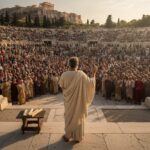Faith as Action: How Scripture and Cognitive Science Reveal a Pattern for Spiritual Growth
Humans Don’t Just Believe — We Act
Every human being operates through a built-in pattern:
we think, we act, and we evaluate.
Cognitive scientists describe this as a feedback loop, the mechanism through which people learn skills, solve problems, and grow in expertise.
But this loop doesn’t just shape careers or competencies.
It also shapes how people live out their beliefs — or fail to.
And this is where the Bible enters the picture. Scripture presents faith not as mental agreement, but as trust expressed through action, continually refined through reflection, repentance, and spiritual guidance. When we understand this natural human loop, we can better understand how biblical faith actually works.
Part 1 — The Human Cognitive Loop: A Tool Built into Creation
Modern cognitive science shows that humans naturally move through three phases:
1. Evaluate / Understand
Gather information, weigh options, consider consequences.
2. Act / Implement
Choose a path and take action based on your evaluation.

3. Reflect / Adjust
Review results, learn from mistakes, refine future choices.
This loop is how people become experts, master craftsmen, leaders, or athletes.
But there’s also a catch:
The mind naturally prefers comfort over continued growth.
Once a person finds what seems “good enough,” they tend to relax into it — trusting leaders uncritically, repeating familiar patterns, settling into beliefs that feel safe, or ignoring inconsistencies that require effort to examine.
This natural tendency toward comfort also explains why even experts can become locked into a familiar way of doing things. The cognitive loop keeps running — they think, act, and evaluate — but the evaluation becomes shallow because the method “works well enough.” Over time their approach becomes rigid. Then someone with a fresh perspective enters the field and re-examines the assumptions the expert stopped questioning, and suddenly a new method emerges that revolutionizes the process. The difference isn’t intelligence — it’s whether the reflective part of the loop stayed active or settled into maintenance mode.
Part 2 — What Faith Really Is: Trust That Acts
Biblical faith takes this same natural loop and infuses it with divine purpose.
Faith is not simply believing ideas.
Faith is acting on God’s instruction because you trust Him, even before you fully understand the outcome.
This is why Scripture repeatedly connects faith and obedience:
- “By faith Abraham obeyed.” — Heb. 11:8
- “Faith without works is dead.” — Jas. 2:26
- “If you love Me, keep My commandments.” — Jn. 14:15
- “Whoever hears My words and does them…” — Matt. 7:24
In other words:
Faith = Trust → Action → Growth
Not action to earn salvation, but action that reveals genuine trust.
Part 3 — The Three Inputs of Biblical Growth: Instruction, Spirit, Faith
Faith operates through three essential ingredients:
1. Instruction (Torah / God’s Word)
Not “law” as a rigid rulebook, but God’s guidance, His explanation of how life works.
Scripture gives the framework for wisdom, character, priorities, and relationships.
2. Spirit (Discernment and Understanding)
The Spirit shapes how we understand instruction — moving us beyond surface-level obedience into deeper motives, intentions, and character formation.

- “The Spirit will guide you into all truth.” — Jn. 16:13
- “God has revealed… by His Spirit.” — 1 Cor. 2:10
3. Faith (Acting on What God Says)
This is where the loop becomes spiritual.
Faith takes instruction + Spirit-illumined wisdom and puts it into practice.
Part 4 — The Spiritual Cognitive Loop: How Faith Actually Works
Here is the real insight you’ve articulated.
Faith is not abstract — it is expressed through an intentional cycle:
**Step 1 — Instruction + Understanding
This requires:
- Reading and studying Scripture
- Praying for insight
- Meditating on God’s motives behind each command
- Planning how to apply it today
Example planning questions:
- “How will I guard my eyes and thoughts today?”
- “How will I speak truthfully?”
- “What temptations do I need to watch for?”
This step mirrors the biblical call to spiritual preparation:
- “Ponder the path of your feet.” — Prov. 4:26
- “In all your ways acknowledge Him.” — Prov. 3:6
- “Let the word of Christ dwell in you richly.” — Col. 3:16
**Step 2 — Action (Faith)
“Because I trust God, I will live this out.”**
Faith expresses itself in actual behavior:
- Choosing honesty when lying is easier
- Rejecting lust when temptation appears
- Forgiving someone who wronged you
- Being generous despite uncertainty
- Speaking kindly instead of retaliating
This is the Hebrews 11 definition of faith:
doing something because you believe God’s word is true and beneficial.

**Step 3 — Reflection (Evaluation)
“How did I walk today?”**
This is where maturity happens:
- Where did I fall short?
- What does failure reveal about my heart?
- What patterns need to change?
- Where did obedience bring unexpected peace, clarity, or blessing?
- How does this shape tomorrow’s choices?
This step mirrors:
- “Examine yourselves…” — 2 Cor. 13:5
- “Let a man examine himself…” — 1 Cor. 11:28
- “Consider your ways.” — Hag. 1:5
- “Confess your sins…” — 1 Jn. 1:9
Reflection becomes repentance → renewal → re-planning.
The loop begins again the next day — stronger, clearer, more aligned with God.
Part 5 — Biblical Illustrations of This Pattern
Abel vs. Cain
Abel acts in alignment with revealed instruction.
Cain acts from self-defined logic.
Abel’s faith involves obedience; Cain’s “faith” is trust in himself.
The loop reveals two very different heart orientations.
Job
Throughout the book, Job wrestles, questions, reflects, and adjusts.
His friends rely on rigid assumptions — a “settled” loop without reflection.
Job’s faith is active, dynamic, and responsive, even though imperfect.
Abraham
He obeyed before he understood the outcomes — the model of “faith as action.”
Jesus’ disciples
They learned by doing.
Jesus constantly gave them tasks, then corrected and taught based on reflection.
Part 6 — Why People Fail at Faith: The Comfort Trap
This natural inclination toward comfort explains why many people place faith in external structures — churches, leaders, denominations, political parties, ideologies — instead of placing their trust in God as a living, guiding source.
Once we “settle,” the mind shifts into preservation mode. We start selectively filtering information: noticing what supports our stance and quietly ignoring what challenges it. Over time, th
- Motivated reasoning: allowing our thought processes to arrive at the conclusion that feels least uncomfortable.
In practical terms, this is why experts can become locked into a particular method or interpretation even when conditions change — it’s easier to protect what’s familiar than to re-evaluate it. And it’s often someone with a fresh perspective who breaks the cycle and brings clarity or innovation.
Spiritually, the same dynamic applies. There is a difference between faith as a living process and faith as static belief. Static faith becomes habitual, defensive, and comfort-driven. Living faith is an active, ongoing engagement with God — a continual, Spirit-led cognitive loop that is willing to be challenged, refined, and transformed.is becomes a spiritual autopilot that feels safe, but keeps us from growing.
Psychologists describe this drift toward comfort in several ways:
- Confirmation bias: favoring evidence that supports the beliefs we already hold.
- In-group bias: valuing whatever keeps us aligned with the group we belong to.
Concluding Thoughts: Faith Is Practiced, Not Passively Possessed
Faith is not merely believing God exists.
It is living as if what God says is true, and discovering through experience that He is faithful.
The Spirit guides.
The Word instructs.
But only faith — action — completes the process.
This is the biblical pattern for spiritual growth:
Study → Act → Reflect → Repeat
Not to earn salvation, but to grow into the character God is building in His children.
This is the path of discipleship, wisdom, and maturity — a path walked step by step, day by day, in the rhythm of faith-filled obedience.


